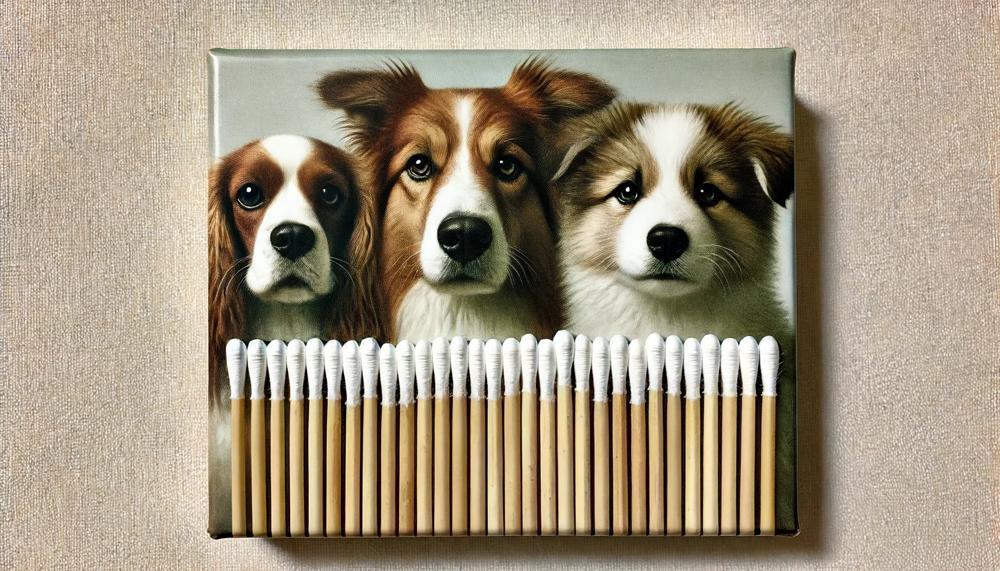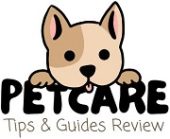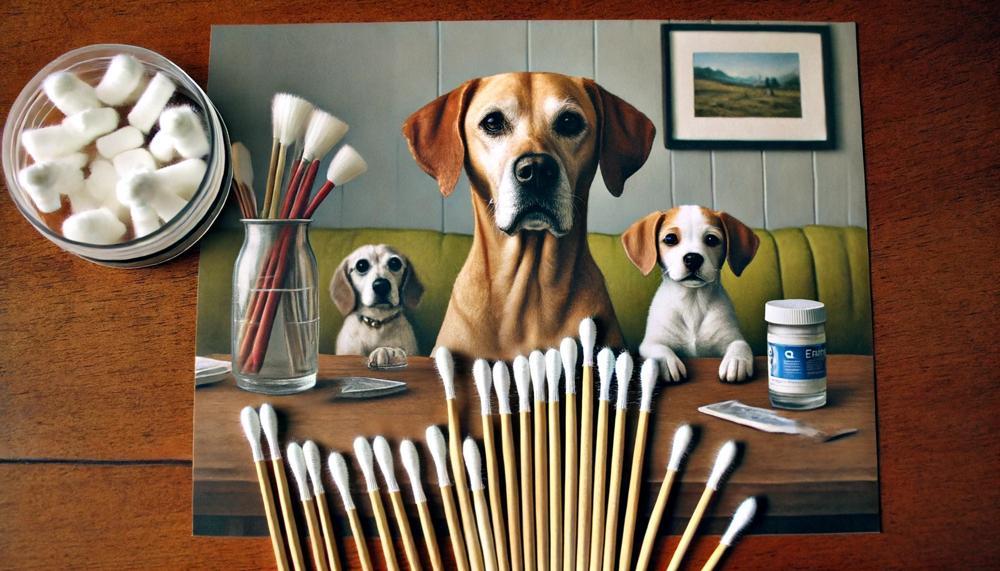Did you know that nearly every dog, at some point in their life, will chomp on something they shouldn’t? Among the array of forbidden snacks, Q-tips often top the list. This peculiar choice of chew toy isn’t just a testament to a dog’s quirky taste; it speaks volumes about their sensory-driven curiosity and the hazards lurking in plain sight within our homes.
Understanding why our furry friends gravitate towards these cotton-tipped sticks can prevent potential health risks and save us from costly vet visits.
In this article, we’ll explore the surprising reasons behind dogs’ fascination with Q-tips and how you can curb this risky behavior. Here are the key takeaways:
- Scent and Texture: Discover how the unique smell and feel of Q-tips often mimic that of their favorite things.
- Seeking Attention: Learn about the behavioral aspect where dogs might use such actions to grab your attention.
- Preventative Strategies: Get equipped with effective strategies to keep these and other hazardous items out of paw’s reach.
- Health Implications: Understand the risks associated with ingesting Q-tips and what to do if your dog ingests one.
Join us as we delve into the why and how of this odd dog behavior, equipping you with the knowledge to ensure your pet’s safety and well-being.
Q-Tip Construction
Table of Contents
Q-Tips, commonly recognized in the realm of pet grooming, are meticulously crafted to cater to various grooming needs, especially for dogs. They consist of a slender stick, typically made from wood, plastic, or biodegradable materials, with soft, absorbent cotton wrapped tightly at both ends.

This design ensures precision and gentleness, making them perfect for cleaning and caring for sensitive areas such as a dog’s ears and eyes.
What Makes Q-Tips Appealing to Dogs?
Dogs are naturally curious creatures and are often attracted to the soft texture and the ease with which Q-Tips can be manipulated or chewed. The small, portable nature of Q-Tips also makes them intriguing for dogs, as they can easily be carried in the mouth and played with. Additionally, the scent and taste of the cotton, especially if it has been in contact with their owner, can be appealing to a dog’s keen sense of smell and taste.
Detailed Explanation Using a Table:
| Feature | Description | Benefit to Dogs |
| Soft Cotton Ends | Each Q-Tip has absorbent cotton at both ends. | Safe for use on sensitive areas like ears and eyes, reducing irritation. |
| Longer Handles | Some Q-Tips are designed with extended handles for better reach. | Allows pet owners to clean difficult-to-reach areas safely and comfortably. |
| Material | Constructed from wood, plastic, or eco-friendly materials. | Chewable and intriguing for dogs, especially when they find them during play. |
So, the dual-ended soft cotton tips, coupled with the handle’s length and material, make Q-Tips not only a useful grooming aid but also an item of interest for dogs. When using Q-Tips for dog grooming, always supervise your pet to ensure they do not ingest or misuse them.
Risk to the Intestines
When dogs ingest Q-tips, their intestines face multiple risks, ranging from physical blockages to potential exposure to harmful chemicals.
| Risk | Consequences | Preventive Measures |
| Physical Obstructions | Blockages, possible surgery | Keep Q-tips out of reach |
| Choking Hazard | Airway obstruction, emergency vet visit | Supervise playtime |
| Chemical Contamination | Gastrointestinal irritation, poisoning | Proper disposal after use |
| Dental Damage | Tooth and gum injuries | Provide safe chew toys |
In essence, while Q-tips can seem innocuous, their potential to cause serious intestinal and other health issues in dogs is significant.
Dog’s Size and Quantity of Q-Tips Ingested Matters
Impact of Dog Size on Health Risks:
| Dog Size | Risk Level | Reason |
| Small Breeds (e.g., Chihuahua) | Higher Risk | Smaller intestinal diameter makes it difficult to pass foreign objects like Q-tips, increasing risk of obstruction. |
| Large Breeds (e.g., Rottweiler) | Lower Risk | Larger intestinal diameter aids in passing foreign material more easily, reducing the chance of complications. |
Effects of Quantity of Q-Tips Ingested:
| Quantity of Q-Tips | Potential Health Impact | Advised Action |
| Single Q-Tip | Possibly harmless but monitoring needed | Watch for any signs of discomfort or unusual behavior; consult a vet if concerned. |
| Multiple Q-Tips | Increased risk of gastrointestinal blockage | Seek immediate veterinary care to prevent severe complications. |
Behavioural Changes and Health Signs to Watch:
- Restlessness or anxiety can indicate discomfort or pain from a potential blockage.
- Reduced appetite or difficulty defecating suggests a digestive disturbance or obstruction.
- Chewing or biting at the abdomen could be a sign of pain.
Preventative Measures and Immediate Actions:
- Safeguard your home: Keep bathroom doors closed and use covered trash bins to limit your dog’s access to Q-tips.
- Immediate response: If ingestion occurs, providing a bland, high-fiber diet, such as white bread or pumpkin, might help facilitate the passage of the Q-tip. However, always consult with your veterinarian first.
Signs of Concern
When it comes to caring for our canine companions, understanding the risks associated with seemingly innocuous household items like Q-tips is crucial.
If your dog has ingested a Q-tip, observing their behavior closely for specific symptoms is imperative. Here’s a breakdown of the signs that should prompt a swift visit to the veterinarian:
| Symptom | Description | Action |
| Behavioural Changes | Unusual lethargy, apparent discomfort, or restlessness. | Monitor closely; if persistent, visit vet. |
| Painful Abdomen | Whining, flinching upon touch, or a distended stomach. | Immediate veterinary consultation required. |
| Vomiting | Frequent attempts to vomit or actual vomiting, which might include visible fragments of the Q-tip. | Contact vet promptly. |
| Eating and Digestive Issues | Refusal to eat, difficulty passing stools, or diarrhea. | Visit vet if symptoms persist over a day. |
| Signs of Internal Blockage | Severe lethargy, continuous vomiting, a bloated abdomen, no bowel movement. | Urgent veterinary emergency. |
If you observe any of these symptoms, especially in combination, do not delay in seeking veterinary care. Early intervention can be pivotal, particularly if the Q-tip has a plastic stick, which poses a greater risk of causing internal injuries or blockages. Remember, a proactive approach can save your dog from serious health complications.
Reach Out to Your Veterinarian
If your dog has swallowed a Q-tip, the urgency to contact your veterinarian depends on several critical factors. Below is a straightforward guide that explains when to seek veterinary assistance:
| Scenario | Action | Reason |
| Dog ingests a Q-tip | Contact vet immediately | Potential internal obstruction |
| Signs of discomfort (vomiting, lethargy, etc.) | Contact vet immediately | Symptoms may indicate serious issues |
| No immediate symptoms | Consult with your vet | Precautionary measure |
By following these guidelines, you ensure the best care for your dog, prioritizing their health and safety.
Diagnostics
When dogs inadvertently swallow foreign objects like Q-tips, it can be troubling for pet owners. Understanding the signs and knowing how to respond is crucial for ensuring the safety and well-being of your canine companion.
| Signs Your Dog May Have Swallowed a Q-tip | Immediate Actions to Take | Follow-Up Care |
|
|
|
| Long-Term Considerations | Keep hazardous objects like Q-tips out of reach and consider covering your bins to prevent similar incidents. | |
Key Takeaways: If you suspect your dog has swallowed a Q-tip, observe them for signs like increased swallowing, abdominal discomfort, or changes in eating and behaviour. Immediate consultation with a vet is crucial, and follow their instructions precisely. Avoid home remedies such as inducing vomiting, as these can exacerbate the situation. Monitoring and adjusting your home environment to ensure it is safe and free from similar hazards will help prevent future occurrences.
Ways to Keep Your Dog Safe
Protecting your dog from the hazards of items like Q Tips involves straightforward, practical steps that can be easily implemented in any household.
Secure Storage
Keep Q Tips and similar small items out of your dog’s reach by storing them in secure containers or drawers. This is a critical step to ensure these items are not accessible to your curious pet.
| Item | Storage Solution | Effectiveness |
| Q Tips | Closed cabinets or containers with child-safe latches | High |
| Other small household items | Drawers or bins with secure closures | High |
Obedience Training
Train your dog with commands like “leave it” or “drop it” to prevent them from picking up or chewing on inappropriate objects. Consistent training sessions enhance your dog’s ability to obey these commands in critical moments.
Appropriate Chew Toys
Provide your dog with suitable alternatives to satisfy their chewing instinct. Ensure these toys are durable and safe, and check them regularly for signs of wear and tear.
| Type of Toy | Description | Safety Check Frequency |
| Hard rubber toys | Designed for durability and long-lasting engagement | Monthly |
| Edible chews | Safe for ingestion and can help clean teeth | As used |
Supervised Play
Keep a watchful eye on your dog during playtime to quickly intervene if they begin to chew on something dangerous. This is especially important if your dog has shown interest in small household items in the past.
Proper Waste Disposal
Use dog-proof trash receptacles to prevent your pet from scavenging through garbage that might contain harmful items like Q Tips. This not only applies to your bathroom but any area your dog can access.
Get Dogster in your inbox.
To receive regular updates from Dogster directly in your inbox, including details on all things canine and insights on peculiar habits such as why dogs might nibble on Q tips, follow these straightforward steps:
- Visit the Dogster Website: Navigate to the Dogster homepage.
- Subscribe to the Newsletter: Locate and click on the “Subscribe” button at the upper right corner of the page.
- Enter Your Email: Input your email address in the provided field.
- Confirm Subscription: Click “Subscribe” to confirm your interest.
By subscribing, you’ll gain access to a treasure of information, from dog health and behavior to training and beyond.
This subscription will ensure you’re among the first to receive updates on new articles, videos, and forum discussions that can enhance your understanding and care of your furry friend.
Conclusion
When dogs engage with Q-tips, they’re not just drawn to a potential chew toy but are interacting with a world rich in sensory experiences that tap into their instinctual curiosities. This seemingly odd behavior underlines a multifaceted blend of scent, texture, and the allure of what these simple items represent. Through understanding these aspects, we empower ourselves to better safeguard our beloved pets and curtail their risky explorations.
At the heart of a dog’s fascination with Q-tips is their sensory-driven curiosity. These cotton-tipped sticks, often carrying familiar human scents, present an irresistible puzzle, combining the thrill of the hunt with the satisfaction of tactile exploration. This inclination isn’t merely about the joy found in the texture or taste; it’s also a silent call for attention, a playful nudge towards interaction that dogs cleverly employ.
Addressing this behavior isn’t just about removal but involves engaging dogs in a way that redirects their curiosity safely. Introducing appropriate toys and consistent training can provide the mental and physical stimulation needed to deter interest in household items like Q-tips. Moreover, understanding the potential health risks—from gastrointestinal blockages to chemical intoxications—highlights the critical need for vigilant pet-proofing practices.
As pet owners, our role extends beyond observation to proactive prevention. By keeping such items out of reach and maintaining a stimulating environment, we ensure our dogs can explore their world safely, without turning to hazardous alternatives like Q-tips.






